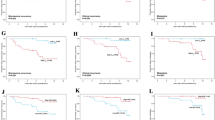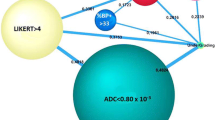Immunohistochemical and morphometric analysis of the microcirculatory bed in the tumor and non-tumor parenchyma of the prostate was carried out with the use of endothelial cell marker CD34 in patients treated by high-intensity focused ultrasound (HIFU). The numerical density of microvessels in the adenocarcinoma focus did not correlate with the degree of its differentiation, while high values of this parameter were associated with lower incidence of local progression after HIFU. Effective HIFU ablation led to progressive fibrosis and significant reduction of the microcirculatory bed in zones of intact non-tumor glands in control samples; an inverse relationship between the degree of reduction of the microcirculatory bed and the probability of relapse was revealed. The use of HIFU in combination with androgen deprivation was associated with a decrease in numerical density of microvessels in zones of tumor and non-tumor parenchyma in patients with relapses.
Similar content being viewed by others
References
Merabishvili VM, Petrova NG, Atroshchenko AV, Kharitonov MV. Epidemiology of prostate cancer (cohort study). Vopr. Onkol. 2014;60(4):458-463. Russian.
Neimark AI, Tachalov MA, Neimark BA. Adjuvant hormone therapy in patients undergoing high-intensity focused ultrasound therapy for locally advanced prostate cancer. Onkourologiya. 2014;(3):69-72. Russian.
Fomkin RN, Voronina ES, Popkov VM, Maslyakova GN, Blumberg BI. Prognostic role of the biomolecular, morphological and clinical markers in the assessment of the efficacy of the treatment for localized prostate cancer using high-intensity focused ultrasound. Eksp. Klin. Urolog. 2013;(4):29-33. Russian.
Aslan G, Cimen S, Yorukoglu K, Tuna B, Sonmez D, Mungan U, Celebi I. Vascular endothelial growth factor expression in untreated and androgen-deprived patients with prostate cancer. Pathol. Res. Pract. 2005;201(8-9):593-598.
Biermann K, Montironi R, Lopez-Beltran A, Zhang S, Cheng L. Histopathological findings after treatment of prostate cancer using high-intensity focused ultrasound (HIFU). Prostate. 2010;70(11):1196-1200.
Chaussy CG, Thuroff S. High-Intensity focused ultrasound for the treatment of prostate cancer: a review. J. Endourol. 2017;31(1):S30-S37.
Colombel M, Filleur S, Fournier P, Merle C, Guglielmi J, Courtin A, Degeorges A, Serre CM, Bouvier R, Clézardin P, Cabon F. Androgens repress the expression of the angiogenesis inhibitor thrombospondin-1 in normal and neoplastic prostate. Cancer Res. 2005;65(1):300-308.
Godoy A, Watts A, Sotomayor P, Montecinos VP, Huss WJ, Onate SA, Smith GJ. Androgen receptor is causally involved in the homeostasis of the human prostate endothelial cell. Endocrinology. 2008;149(6):2959-2969.
Miyata Y, Mitsunari K, Asai A, Takehara K, Mochizuki Y, Sakai H. Pathological significance and prognostic role of microvessel density, evaluated using CD31, CD34, and CD105 in prostate cancer patients after radical prostatectomy with neoadjuvant therapy. Prostate. 2015;75(1):84-91.
Nagy JA, Chang SH, Dvorak AM, Dvorak HF. Why are tumour blood vessels abnormal and why is it important to know. Br. J. Cancer. 2009;100(6):865-869.
Rubin MA, Buyyounouski M, Bagiella E, Sharir S, Neugut A, Benson M, de la Taille A, Katz AE, Olsson CA, Ennis RD. Microvessel density in prostate cancer: lack of association with tumor grade, pathologic stage and clinical outcome. Urology. 1999;53(3):542-547.
Russo G, Mischi M, Scheepens W, De la Rosette JJ, Wijkstra H. Angiogenesis in prostate cancer: onset, progression and imaging. BJU Int. 2012;110:794-808.
Warmuth M, Johansson T, Mad P. Systematic review of the efficacy and safety of high-intensity focussed ultrasound for the primary and salvage treatment of prostate cancer. Eur. Urol. 2010;58(6):803-815.
Wu F, Chen WZ, Bai J, Zou JZ, Wang ZL, Zhu H, Wang ZB. Tumor vessel destruction resulting from high-intensity focused ultrasound in patients with solid malignancies. Ultrasound Med Biol. 2002;28(4):535-542.
Author information
Authors and Affiliations
Corresponding author
Additional information
Translated from Byulleten’ Eksperimental’noi Biologii i Meditsiny, Vol. 165, No. 5, pp. 628-634, May, 2018
Rights and permissions
About this article
Cite this article
Bakarev, M.A., Levin, V.P., Kachesov, I.V. et al. Status of the Microcirculatory Network as a Factor of Prognosis and Evaluation of Therapeutic Efficiency in Prostate Cancer Treated by High-Intensity Focused Ultrasound in Combination with Androgen Deprivation. Bull Exp Biol Med 165, 682–687 (2018). https://doi.org/10.1007/s10517-018-4241-4
Received:
Published:
Issue Date:
DOI: https://doi.org/10.1007/s10517-018-4241-4




